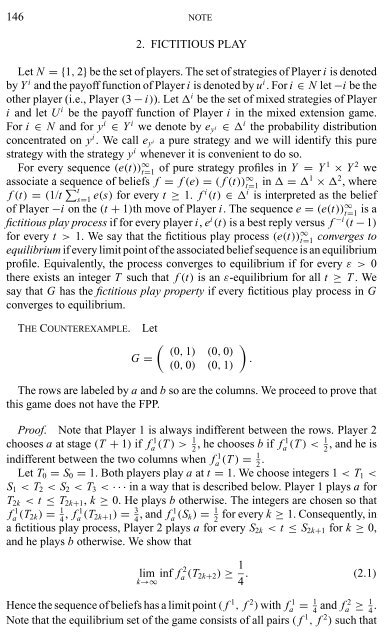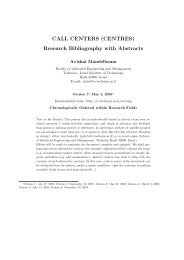A 2 x 2 Game without the Fictitious Play Property - David Levine's ...
A 2 x 2 Game without the Fictitious Play Property - David Levine's ...
A 2 x 2 Game without the Fictitious Play Property - David Levine's ...
You also want an ePaper? Increase the reach of your titles
YUMPU automatically turns print PDFs into web optimized ePapers that Google loves.
146 NOTE<br />
2. FICTITIOUS PLAY<br />
Let N ={1,2}be <strong>the</strong> set of players. The set of strategies of <strong>Play</strong>er i is denoted<br />
by Y i and <strong>the</strong> payoff function of <strong>Play</strong>er i is denoted by u i .Fori ∈ Nlet −i be <strong>the</strong><br />
o<strong>the</strong>r player (i.e., <strong>Play</strong>er (3 − i)). Let i be <strong>the</strong> set of mixed strategies of <strong>Play</strong>er<br />
i and let U i be <strong>the</strong> payoff function of <strong>Play</strong>er i in <strong>the</strong> mixed extension game.<br />
For i ∈ N and for y i ∈ Y i we denote by ey i ∈ i <strong>the</strong> probability distribution<br />
concentrated on yi . We call eyi a pure strategy and we will identify this pure<br />
strategy with <strong>the</strong> strategy yi whenever it is convenient to do so.<br />
For every sequence (e(t)) ∞ t=1 of pure strategy profiles in Y = Y 1 × Y 2 we<br />
associate a sequence of beliefs f = f (e) = ( f (t)) ∞ t=1 in = 1 × 2 , where<br />
f (t) = (1/t t s=1 e(s) for every t ≥ 1. f i (t) ∈ i is interpreted as <strong>the</strong> belief<br />
of <strong>Play</strong>er −i on <strong>the</strong> (t + 1)th move of <strong>Play</strong>er i. The sequence e = (e(t)) ∞ t=1 is a<br />
fictitious play process if for every player i, ei (t) is a best reply versus f −i (t − 1)<br />
for every t > 1. We say that <strong>the</strong> fictitious play process (e(t)) ∞ t=1 converges to<br />
equilibrium if every limit point of <strong>the</strong> associated belief sequence is an equilibrium<br />
profile. Equivalently, <strong>the</strong> process converges to equilibrium if for every ε>0<br />
<strong>the</strong>re exists an integer T such that f (t) is an ε-equilibrium for all t ≥ T .We<br />
say that G has <strong>the</strong> fictitious play property if every fictitious play process in G<br />
converges to equilibrium.<br />
THE COUNTEREXAMPLE. Let<br />
G =<br />
(0, 1) (0,0)<br />
(0,0) (0,1)<br />
The rows are labeled by a and b so are <strong>the</strong> columns. We proceed to prove that<br />
this game does not have <strong>the</strong> FPP.<br />
Proof. Note that <strong>Play</strong>er 1 is always indifferent between <strong>the</strong> rows. <strong>Play</strong>er 2<br />
chooses a at stage (T + 1) if f 1 1<br />
1 1<br />
a (T )> , he chooses b if f 2 a (T )< , and he is<br />
2<br />
indifferent between <strong>the</strong> two columns when f 1 1<br />
a (T ) = 2 .<br />
Let T0 = S0 = 1. Both players play a at t = 1. We choose integers 1 < T1 <<br />
S1 < T2 < S2 < T3 < ···in a way that is described below. <strong>Play</strong>er 1 plays a for<br />
T2k < t ≤ T2k+1, k ≥ 0. He plays b o<strong>the</strong>rwise. The integers are chosen so that<br />
f 1<br />
a (T2k) = 1 1 , f 4 a (T2k+1) = 3 1 , and f 4 a (Sk) = 1<br />
for every k ≥ 1. Consequently, in<br />
2<br />
a fictitious play process, <strong>Play</strong>er 2 plays a for every S2k < t ≤ S2k+1 for k ≥ 0,<br />
and he plays b o<strong>the</strong>rwise. We show that<br />
2<br />
lim inf fa k→∞ (T2k+2) ≥ 1<br />
<br />
.<br />
Hence <strong>the</strong> sequence of beliefs has a limit point ( f 1 , f 2 ) with f 1<br />
a<br />
. (2.1)<br />
4<br />
= 1<br />
4<br />
and f 2<br />
a<br />
≥ 1<br />
4 .<br />
Note that <strong>the</strong> equilibrium set of <strong>the</strong> game consists of all pairs ( f 1 , f 2 ) such that
















